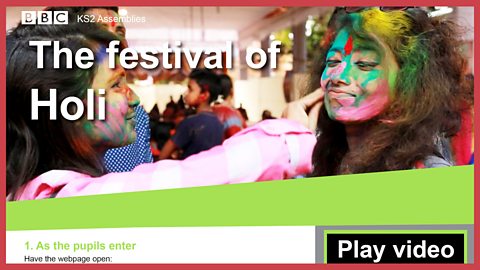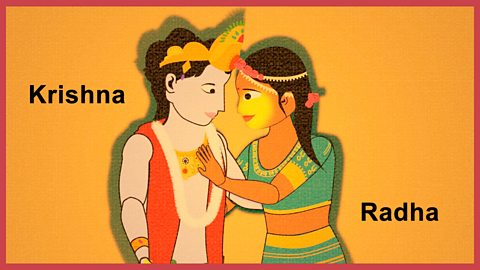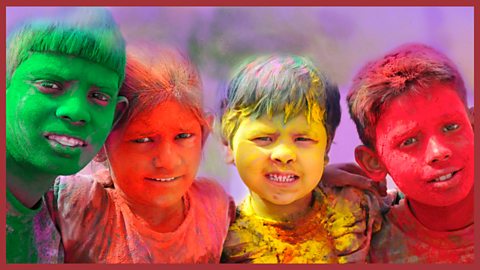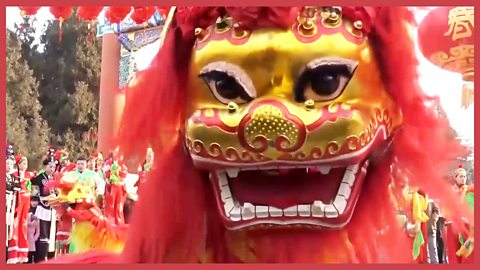±«Óătv Teach > School Radio > Assemblies > Holi
SMSC - Festivals - Calendar - Philosophical - Treasure Champs - Songs
In short...
Themes: Spring festivals; celebrations; Hinduism; Holika and Prahlad; Krishna and Radha.
Summary: Holi is one of the most important festivals celebrated by Hindus. The festival remembers the legend of Prahlad and the demon, Holika. During the festival people smear each other in bright coloured powder - called gulal - which recalls the story of Krishna and his love for Radha. In 2024 Holi begins on 25 March.
Resources: The . The assembly also includes an .

The video
A young Hindu describes what happens during Holi and reveals what she loves about the festival, which is often referred to as the 'festival of colour'.
Holi begins with Holika Dahan, when bonfires are lit to remember the story of Holika and Prahlad. On the second day - Rangwali Holi - people cover each other in brightly coloured paint called gulal to remember the love story of Krishna and Radha.
The video illustrates the colourful traditions of Holi as well as including two short animations of the stories associated with the festival.
Duration: 4' 14"
End of speech: 'âŠAnd that's why I love Holi!' + images of children celebrating.
Video questions
- How many days does Holi last for? (2 days: Holika Dahan and Rangwali Holi)
- What story about good and evil does Holi remember? (The story of Holika and Prahlad)
- What is the coloured power called? (Gulal)
- Why do people cover each other in the powder? (To remember the story of Krishna and his love for Radha - thus it's a way of showing love for each other)
- What do the different colours of the powder mean? (Blue is for the gods / Red is for love and fertility / Yellow is for knowledge and learning / Green is for nature and the start of spring)

Key links
Download / print the framework ready for use

Click to display the image full-size

Click to display the image full-size


Suggested framework
1. Entry music
Traditional Indian music - selected from an online search.
2. Introduction
Tell the assembly that today they will be finding out about a Hindu festival called 'Holi'. Explain to the group that Holi has its roots in Hindu communities in India and Nepal, but that it is celebrated by people from Hindu and non-Hindu communities all over the world. Ask the children to be on the lookout for information on the meanings behind the traditions of Holi.
3. The video
Play the video. The duration is 4' 14" and the final words are: 'âŠand that's why I love Holi!'
4. After the video
Ask the children: âTurn to the person next to you and tell them which part of the Holi festival you would find the most fun.â
5. Time to talk
Use the Video questions to lead a discussion about what the children have watched:
- 'The Holi festival is about colour, light and new beginnings. Can anyone tell us how many days Holi Festival lasts for?â (2 days).
- 'What story about good and evil does Holi remember?' (Holika and Prahlad). Wait for responses and follow-up with: âWhat can we learn from this story?â (Look for an awareness of good triumphing over evil or good over bad).
- âThe second day of the Holi festival is filled with lots of celebrations such as traditional music and dancing. Another central tradition is colour. Can anyone remember what the colourful powder was called that people cover each other in during Holi celebrations?â (Gulal).
- âCan anyone remember why people cover themselves in the colourful powder?â (Look for an awareness of the story of Krishna and Radha, or more broadly of people showing a sign of love). Wait for responses and follow-up with: âCan anyone remember what the different colours that people use mean?â (Blue = represents the gods; Red = love and fertility; yellow = knowledge and learning; green = nature and the start of spring).
6. Opportunity to sing
An opportunity to sing your chosen song. Suggestions from ±«Óătv collections below.
7. Opportunity to reflect
Focus your reflection on the core themes of the Holi festival - love, new beginnings and happiness.
Holi is a time for thinking about love, new beginnings and happiness.
Think quietly to yourself about the people you love and the things that make you happyâŠ
Sometimes people can be unkind to us - like in the story of Holika and Prahlad - but the festival of Holi celebrates love and good triumphing over badâŠ
It shows us that new beginnings are possibleâŠ
Think about a new beginning you'd like to makeâŠand how you will make it happenâŠ
8. Opportunity for prayer
Begin with your usual form of address ('Dear God', 'Lord Jesus', 'Let us prayâŠ' etc) and:
Thank you for the lessons we can learn from the festival of Holi.
Help us to share happiness and love with our friends and family and celebrate the triumph of good over evil.
Amen.

Suggested songs
Song: 'Being a friend' (All about our school, no 8. Vocal version)
Being a friend is the best thing you can be,
âšâCos in the end friends are something we all need.
You could score a goal for England,âš
Be a pop star on TV,
âšBut being a friendâš
Is still the best thing you can ever be.
Being a friend is the best thing you can do,âš
Time and again itâs our friends that help us through.
You could be a millionaire,âš
Or fly a rocket to the moon,
âšBut being a friendâš
Is still the best thing you can ever do.
Whatever we grow up to be,
And live in harmony,
Together we all need to see
That friendship is the key!
Being a friend is the best thing you can be,âš
âCos in the end friends are something we all need.
You could score a goal for England,
âšBe a pop star on TV,âš
But being a friendâš
Is still the best thing you can ever be.
Being a friend
âšIs still the best thing you can ever be.


Assembly frameworks on related themes
Lunar New Year (Chinese New Year) collection
KS1/KS2. Lunar New Year; festivals; celebrating with friends/family.

±«Óătv Teach > School Radio > Assemblies > Holi
SMSC - Festivals - Calendar - Philosophical - Treasure Champs - Songs